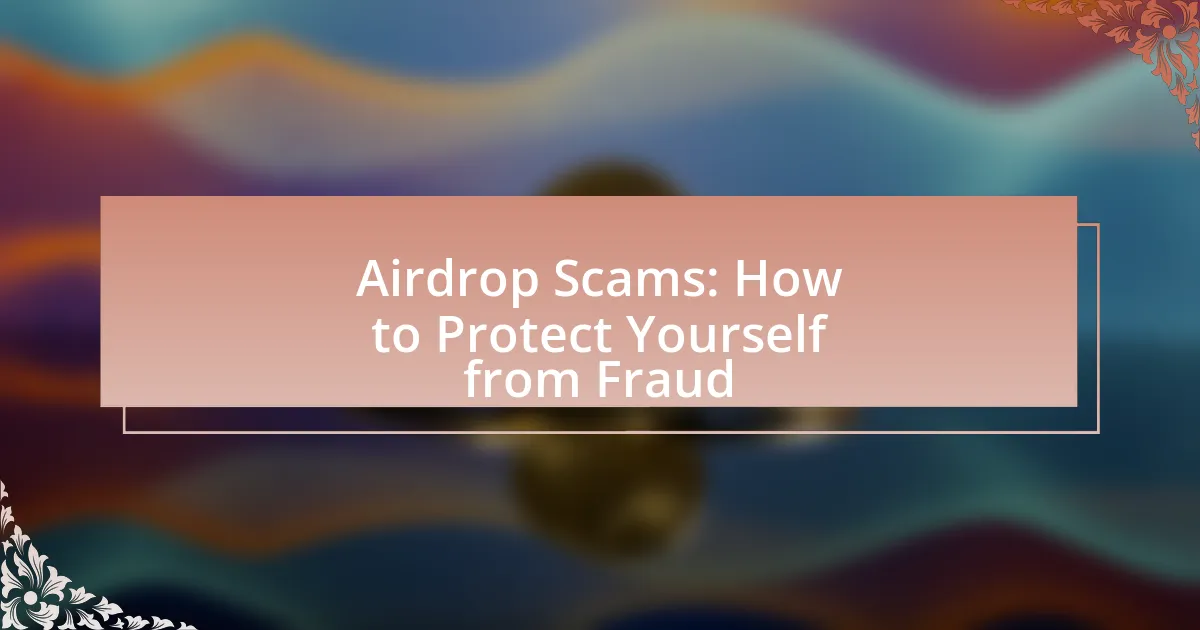Airdrop scams are fraudulent schemes in the cryptocurrency space where scammers distribute fake tokens to unsuspecting users, often requiring personal information or funds to participate. These scams exploit the popularity of legitimate airdrops, with reports indicating that a significant portion of cryptocurrency-related losses, amounting to over $80 million in 2021, stemmed from such fraudulent activities. The article outlines how airdrop scams operate, the tactics used by scammers, and the signs to identify fraudulent airdrops. It also discusses the prevalence of these scams due to the lack of regulation and anonymity in the cryptocurrency market, while providing best practices and resources for individuals to protect themselves from falling victim to these deceptive schemes.

What are Airdrop Scams?
Airdrop scams are fraudulent schemes in which scammers distribute fake cryptocurrency tokens to unsuspecting users, often requiring them to provide personal information or send funds to participate. These scams exploit the popularity of legitimate airdrops, which are promotional events where real projects distribute tokens for free to increase awareness and user engagement. According to a report by the Federal Trade Commission, consumers lost over $80 million to cryptocurrency scams in 2021, highlighting the prevalence and impact of such fraudulent activities.
How do Airdrop Scams operate?
Airdrop scams operate by enticing individuals with the promise of free cryptocurrency or tokens, often requiring them to provide personal information or send funds to participate. Scammers typically create fake websites or social media accounts that mimic legitimate projects, leading victims to believe they are engaging in a genuine airdrop. According to a report by the Blockchain Security Company, 80% of airdrop campaigns are fraudulent, highlighting the prevalence of these scams. Victims often lose their investments or personal data, which can lead to identity theft or financial loss.
What tactics do scammers use in Airdrop Scams?
Scammers in airdrop scams typically use tactics such as impersonation, phishing, and urgency to deceive victims. They often create fake websites or social media profiles that mimic legitimate cryptocurrency projects, leading individuals to believe they are participating in a genuine airdrop. Phishing tactics involve sending emails or messages that prompt users to provide private keys or personal information, often under the guise of verifying their eligibility for the airdrop. Additionally, scammers create a sense of urgency by claiming limited availability or time-sensitive offers, pressuring victims to act quickly without due diligence. These tactics exploit the growing interest in cryptocurrency and airdrops, making it crucial for individuals to verify the authenticity of any airdrop before participating.
How can you identify a fraudulent airdrop?
To identify a fraudulent airdrop, look for signs such as requests for personal information, promises of unrealistic returns, and lack of transparency about the project. Legitimate airdrops typically do not require sensitive data like private keys or passwords, and they provide clear information about their purpose and team. According to a report by the Blockchain Security Alliance, over 60% of reported airdrop scams involve these red flags, highlighting the importance of due diligence before participating in any airdrop.
Why are Airdrop Scams prevalent in the cryptocurrency space?
Airdrop scams are prevalent in the cryptocurrency space primarily due to the lack of regulation and the anonymity that cryptocurrencies provide. This environment allows malicious actors to exploit unsuspecting users by promoting fake airdrops that promise free tokens in exchange for personal information or cryptocurrency. According to a report by the Federal Trade Commission, consumers lost over $80 million to cryptocurrency scams in 2021, with a significant portion attributed to fraudulent airdrops. The combination of high demand for new tokens and the ease of creating fake projects contributes to the frequency of these scams.
What factors contribute to the rise of Airdrop Scams?
The rise of airdrop scams is primarily driven by the increasing popularity of cryptocurrencies and the lack of regulatory oversight in the digital asset space. As more individuals seek to participate in cryptocurrency investments, scammers exploit this interest by creating fraudulent airdrop campaigns that promise free tokens in exchange for personal information or initial investments. According to a report by the Blockchain Transparency Institute, over 90% of airdrops are considered scams, highlighting the prevalence of deceptive practices in this area. Additionally, the anonymity provided by blockchain technology allows scammers to operate without fear of identification or repercussions, further contributing to the surge in airdrop scams.
How does the anonymity of cryptocurrency facilitate these scams?
The anonymity of cryptocurrency facilitates scams by allowing fraudsters to operate without revealing their identities, making it difficult for victims to trace or report them. This lack of accountability encourages malicious actors to exploit unsuspecting individuals through deceptive schemes, such as airdrop scams, where they promise free tokens in exchange for personal information or funds. According to a report by the Federal Trade Commission, consumers lost over $80 million to cryptocurrency scams in 2021, highlighting the significant impact of anonymity in enabling these fraudulent activities.

What are the signs of Airdrop Scams?
Signs of airdrop scams include requests for private keys, promises of unrealistic returns, and the requirement to send cryptocurrency to receive tokens. Scammers often create urgency by claiming limited availability or exclusive access. Additionally, poorly designed websites and lack of verifiable information about the project are common indicators. According to a report by the Federal Trade Commission, consumers lost over $80 million to cryptocurrency scams in 2021, highlighting the prevalence of such fraudulent activities.
How can you spot a suspicious airdrop?
To spot a suspicious airdrop, examine the legitimacy of the project behind it. Airdrops from reputable projects typically have clear communication, established social media presence, and verifiable partnerships. In contrast, suspicious airdrops often lack transparency, have vague or no official websites, and may require personal information or private keys, which legitimate projects never ask for. According to a report by the Blockchain Security Alliance, over 60% of reported airdrop scams involve requests for sensitive information, highlighting the importance of verifying the source before participating.
What red flags should you look for in Airdrop promotions?
Red flags to look for in airdrop promotions include requests for personal information, such as private keys or passwords, which legitimate airdrops never ask for. Additionally, promotions that promise unrealistic returns or require upfront payments are often scams. Airdrops with poorly designed websites or lack of clear information about the project and its team can also indicate fraudulent activity. According to a report by the Blockchain Transparency Institute, over 80% of airdrops are associated with scams, highlighting the importance of vigilance in identifying these warning signs.
How do unrealistic promises indicate a potential scam?
Unrealistic promises often indicate a potential scam because they typically offer returns or benefits that are too good to be true, which is a common tactic used by fraudsters to lure victims. For instance, claims of guaranteed high returns with little to no risk are frequently associated with fraudulent schemes, as legitimate investments do not operate under such conditions. Research by the Federal Trade Commission shows that scams often exploit emotional triggers, making unrealistic promises to create urgency and manipulate individuals into acting quickly without due diligence.
What common types of Airdrop Scams exist?
Common types of airdrop scams include phishing scams, fake airdrop announcements, and social media impersonation. Phishing scams often involve fraudulent emails or messages that request private keys or personal information under the guise of a legitimate airdrop. Fake airdrop announcements typically promise free tokens but require users to send cryptocurrency as a prerequisite, which results in financial loss. Social media impersonation involves scammers creating fake accounts that mimic legitimate projects, misleading users into participating in non-existent airdrops. These scams exploit the popularity of airdrops to deceive individuals, leading to significant financial risks.
What is a phishing airdrop scam?
A phishing airdrop scam is a fraudulent scheme where scammers impersonate legitimate cryptocurrency projects to trick individuals into providing sensitive information or transferring funds. In this scam, victims receive unsolicited messages claiming they have been selected for an airdrop, often accompanied by links to fake websites designed to steal personal data or private keys. According to the Federal Trade Commission, consumers reported losing over $1.4 billion to cryptocurrency scams in 2021, highlighting the prevalence and impact of such fraudulent activities.
How does a fake airdrop website operate?
A fake airdrop website operates by luring users with promises of free cryptocurrency in exchange for personal information or funds. These websites typically mimic legitimate airdrop promotions, using attractive graphics and official-looking branding to gain trust. Once users engage, they are often required to provide sensitive information, such as private keys or wallet addresses, or to send a small amount of cryptocurrency as a prerequisite to receive the promised airdrop. This tactic exploits the user’s desire for free tokens, leading to financial loss and potential identity theft. According to a report by the Federal Trade Commission, consumers lost over $80 million to cryptocurrency scams in 2021, highlighting the prevalence and effectiveness of such fraudulent schemes.

How can you protect yourself from Airdrop Scams?
To protect yourself from airdrop scams, always verify the legitimacy of the project before participating. Scammers often impersonate reputable projects to lure victims, so checking official channels such as the project’s website, social media accounts, and community forums is essential. According to a report by the Blockchain Security Alliance, over 60% of reported airdrop scams involved fake websites mimicking legitimate projects. Additionally, never share your private keys or sensitive information, as legitimate airdrops will never ask for this data.
What best practices should you follow to avoid Airdrop Scams?
To avoid Airdrop scams, always verify the legitimacy of the project before participating. Research the project’s website, social media channels, and community feedback to ensure it is credible. Scammers often impersonate legitimate projects, so checking for official announcements and partnerships can help confirm authenticity. Additionally, never share your private keys or sensitive information, as legitimate airdrops will never ask for this data. According to a report by the Blockchain Security Company, over 90% of airdrop scams involve phishing attempts, highlighting the importance of caution. Always use secure wallets and enable two-factor authentication to further protect your assets.
How can you verify the legitimacy of an airdrop?
To verify the legitimacy of an airdrop, research the project behind it, focusing on its website, whitepaper, and team credentials. A legitimate airdrop typically has a well-documented project with clear goals and a transparent team. Additionally, check community feedback on platforms like Reddit or Twitter, where users often share their experiences. For example, a project with a strong online presence and positive reviews is more likely to be legitimate. Furthermore, ensure that the airdrop does not require sensitive information, such as private keys or passwords, as legitimate airdrops will never ask for this data.
What role does community feedback play in identifying scams?
Community feedback is crucial in identifying scams as it provides real-time insights and warnings from individuals who have experienced or observed fraudulent activities. This collective knowledge helps to create a database of red flags and patterns associated with scams, enabling others to recognize potential threats. For instance, platforms like social media and online forums often feature discussions where users share their experiences with specific airdrop projects, highlighting suspicious behaviors or outcomes. Research indicates that 70% of scam reports come from community members rather than official sources, underscoring the importance of grassroots vigilance in fraud detection.
What tools and resources can help you stay safe?
To stay safe from airdrop scams, utilize tools such as two-factor authentication (2FA) and reputable cryptocurrency wallets. Two-factor authentication adds an extra layer of security by requiring a second form of verification, making unauthorized access more difficult. Reputable cryptocurrency wallets, like Ledger or Trezor, provide secure storage for digital assets and often include features that help identify phishing attempts. Additionally, resources like online security forums and educational websites can offer updated information on the latest scams and protective measures, ensuring users remain informed and vigilant against potential threats.
How can security software assist in preventing scams?
Security software assists in preventing scams by providing real-time protection against malicious activities and identifying fraudulent schemes. It employs advanced algorithms to detect phishing attempts, malware, and suspicious links that are commonly used in scams. For instance, according to a report by the Anti-Phishing Working Group, there was a 220% increase in phishing attacks in 2020, highlighting the need for effective security measures. Security software can also block access to known scam websites and alert users about potential threats, thereby reducing the likelihood of falling victim to scams.
What online resources provide updates on known scams?
Online resources that provide updates on known scams include the Federal Trade Commission (FTC) website, which regularly publishes alerts and consumer warnings about various scams. Additionally, the Better Business Bureau (BBB) offers a Scam Tracker that allows users to report and view scams in their area. Websites like Scamwatch, operated by the Australian Competition and Consumer Commission, also provide information on current scams. These resources are reliable as they are maintained by government agencies and consumer protection organizations dedicated to informing the public about fraudulent activities.
What steps should you take if you fall victim to an Airdrop Scam?
If you fall victim to an Airdrop Scam, immediately secure your cryptocurrency accounts by changing passwords and enabling two-factor authentication. This action helps prevent further unauthorized access to your funds. Next, report the scam to the relevant authorities, such as the Federal Trade Commission (FTC) or your local law enforcement, as this can aid in tracking down the perpetrators. Additionally, inform your cryptocurrency exchange about the incident, as they may provide assistance or monitor for suspicious activity related to your account. Lastly, consider monitoring your financial accounts for any unusual transactions and be vigilant about potential identity theft, as scammers may attempt to exploit your personal information.
How can you report a scam to authorities?
To report a scam to authorities, you should contact your local law enforcement agency or the relevant consumer protection agency in your country. For example, in the United States, you can report scams to the Federal Trade Commission (FTC) through their website or by calling their consumer hotline. Additionally, if the scam involves online fraud, you can report it to the Internet Crime Complaint Center (IC3). These agencies collect information about scams and can take action against perpetrators. Reporting scams helps authorities track and combat fraudulent activities effectively.
What measures can you take to recover lost funds?
To recover lost funds from airdrop scams, individuals should immediately report the incident to their local law enforcement and relevant financial authorities. Reporting to organizations such as the Federal Trade Commission (FTC) or the Internet Crime Complaint Center (IC3) can help in tracking fraudulent activities. Additionally, contacting the cryptocurrency exchange or wallet provider used during the transaction may provide options for recovery, as some platforms have protocols for handling such cases. According to the FTC, victims of scams can sometimes recover funds if they act quickly and provide detailed information about the transaction.
What are the key takeaways for avoiding Airdrop Scams?
To avoid airdrop scams, always verify the legitimacy of the project before participating. Scammers often impersonate reputable projects, so checking official channels like the project’s website and social media accounts is crucial. Additionally, never share your private keys or sensitive information, as legitimate airdrops will never ask for this data. Researching community feedback and reviews can also help identify potential scams, as many users share their experiences online. Lastly, be cautious of offers that seem too good to be true, as they often are; airdrops that promise excessive rewards with little effort are likely fraudulent.


